高中英语必修四教案:第四单元Grammar
- 格式:doc
- 大小:54.50 KB
- 文档页数:6
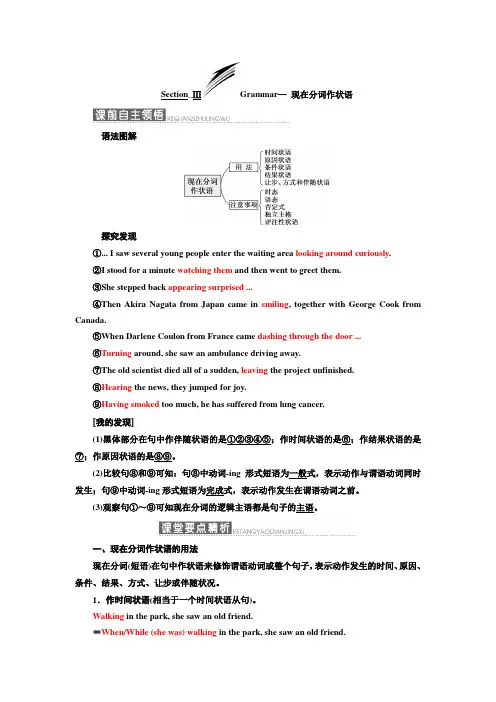
Section_ⅢGrammar—现在分词作状语语法图解探究发现①... I saw several young people enter the waiting area looking around curiously.②I stood for a minute watching them and then went to greet them.③She stepped back appearing surprised ...④Then Akira Nagata from Japan came in smiling, together with George Cook from Canada.⑤When Darlene Coulon from France came dashing through the door ...⑥Turning around, she saw an ambulance driving away.⑦The old scientist died all of a sudden, leaving the project unfinished.⑧Hearing the news, they jumped for joy.⑨Having smoked too much, he has suffered from lung cancer.[我的发现](1)黑体部分在句中作伴随状语的是①②③④⑤;作时间状语的是⑥;作结果状语的是⑦;作原因状语的是⑧⑨。
(2)比较句⑧和⑨可知:句⑧中动词-ing形式短语为一般式,表示动作与谓语动词同时发生;句⑨中动词-ing形式短语为完成式,表示动作发生在谓语动词之前。
(3)观察句①~⑨可知现在分词的逻辑主语都是句子的主语。
一、现在分词作状语的用法现在分词(短语)在句中作状语来修饰谓语动词或整个句子,表示动作发生的时间、原因、条件、结果、方式、让步或伴随状况。
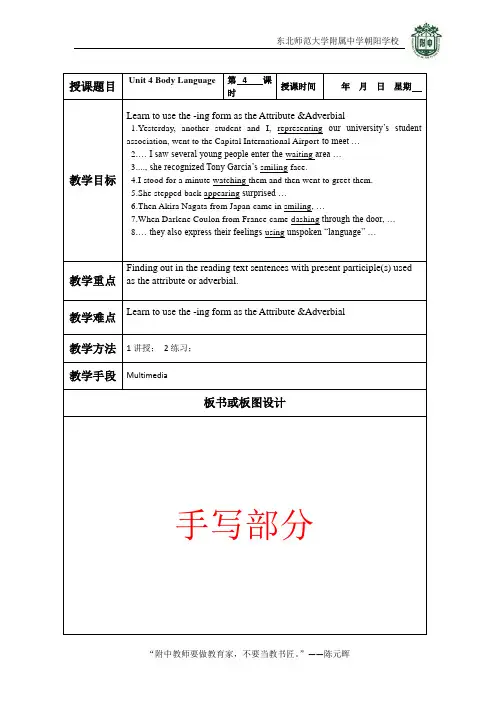
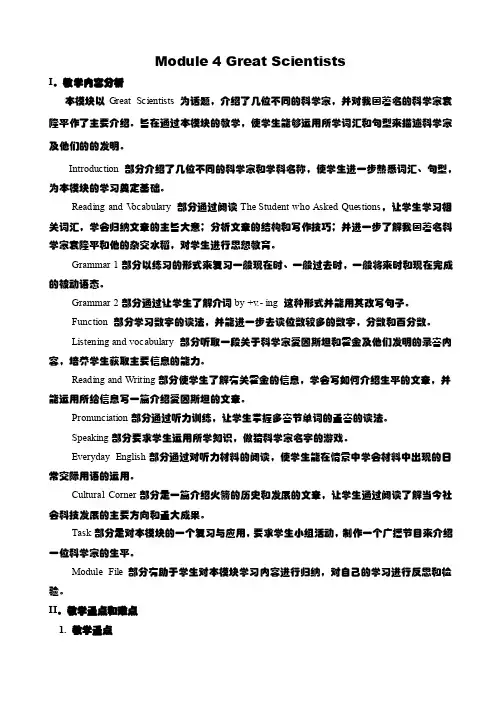
Module 4 Great ScientistsI.教学内容分析本模块以Great Scientists 为话题,介绍了几位不同的科学家,并对我国著名的科学家袁隆平作了主要介绍。
旨在通过本模块的教学,使学生能够运用所学词汇和句型来描述科学家及他们的的发明。
Introduction 部分介绍了几位不同的科学家和学科名称,使学生进一步熟悉词汇、句型,为本模块的学习奠定基础。
Reading and V ocabulary 部分通过阅读The Student who Asked Questions,让学生学习相关词汇,学会归纳文章的主旨大意;分析文章的结构和写作技巧;并进一步了解我国著名科学家袁隆平和他的杂交水稻,对学生进行思想教育。
Grammar 1部分以练习的形式来复习一般现在时、一般过去时,一般将来时和现在完成的被动语态。
Grammar 2部分通过让学生了解介词by +v.- ing 这种形式并能用其改写句子。
Function 部分学习数字的读法,并能进一步去读位数较多的数字,分数和百分数。
Listening and vocabulary 部分听取一段关于科学家爱因斯坦和霍金及他们发明的录音内容,培养学生获取主要信息的能力。
Reading and Writing部分使学生了解有关霍金的信息,学会写如何介绍生平的文章,并能运用所给信息写一篇介绍爱因斯坦的文章。
Pronunciation部分通过听力训练,让学生掌握多音节单词的重音的读法。
Speaking部分要求学生运用所学知识,做猜科学家名字的游戏。
Everyday English部分通过对听力材料的阅读,使学生能在情景中学会材料中出现的日常交际用语的运用。
Cultural Corner部分是一篇介绍火箭的历史和发展的文章,让学生通过阅读了解当今社会科技发展的主要方向和重大成果。
Task部分是对本模块的一个复习与应用,要求学生小组活动,制作一个广播节目来介绍一位科学家的生平。
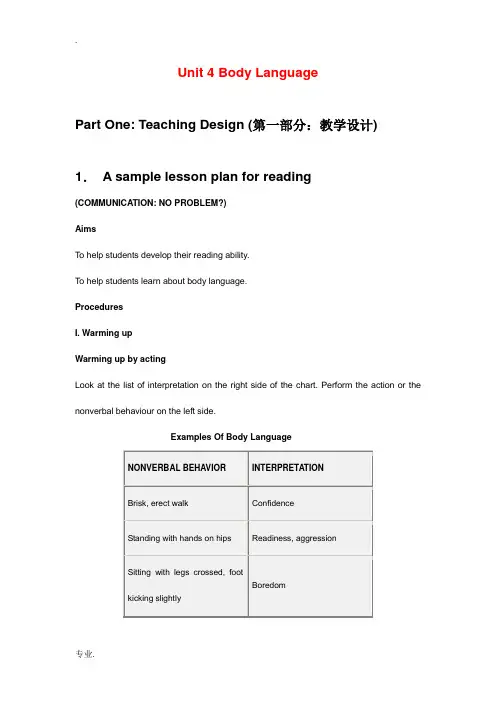
Unit 4 Body LanguagePart One: Teaching Design (第一部分:教学设计)1.A sample lesson plan for reading(COMMUNICATION: NO PROBLEM?)AimsTo help students develop their reading ability.To help students learn about body language.ProceduresI. Warming upWarming up by actingLook at the list of interpretation on the right side of the chart. Perform the action or the nonverbal behaviour on the left side.Examples Of Body LanguageWarming up by defining—What is body language?II. Pre-reading1. Looking and sayingLook at the man in the picture below. What does he say to you by his body language?Basically, how the ...... do I know? Or, I don’t know nothin!The shoulders are hunched and the hands are open signifying a big question mark.2. Talking and sharingBody language is the quiet, secret and most powerful language of all!According to experts, our non-verbal language communicates about 50% of what we really mean (voice tonality contributes 38%) while words themselves contribute a mere 7%.Our bodies send out messages constantly and often we don't recognize that we're communicating a lot more than we realize.Our understanding and use of non-verbal cues in facial expression are familiar to us nearly from birthIII. Reading1. Reading aloud to the recordingNow please listen and read aloud to the recording of the text COMMUNICATION: NO PROBLEM?. Pay attention to the pronunciation of each word and the pauses within each sentence. I will play the tape twice and you shall read aloud twice, too.2. Reading and underliningNext you are to read and underline all the useful expressions or collocations in the passage. Copy them to your notebook after class as homework.3. Reading to identify the topic sentence of each paragraphNext you are to skim the text to identify the topic sentence of each paragraph.4. Reading and transferring informationRead the text again to complete the table. Where is he/ she from? What does he/ she do when he/ she meet someone at the airport for the first time?5. Reading and understanding difficult sentencesAs you have read the text times, you can surely tell which sentences are difficult to understand. Now put your questions concerning the difficult points to me the teacher.6. Reading and translatingNow it’s time to translate the text into Chinese, sentence by sentence. Who will be the first to do it?IV. Closing downClosing down by doing exercisesTo end the lesson you are to do the comprehending exercises No. 1 and 2 on page 26 and 27.Closing down by checkingC heck some of the following basic non-verbal cues and you'll recognize that you already speak and translate much of the language.“I’m surprised!〞“I’m shocked!〞“I’m sad!〞2.A sample lesson plan for Learning about Language (The ~ing form as the Attribute & Adverbial)AimsTo help students learn about The ~ing form as the Attribute & Adverbial.To help students discover and learn to use some useful words and expressions.To help students discover and learn to use some useful structures.ProceduresI. Warming upWarming up by discovering useful words and expressionsTurn to page 27 and do exercises No. 1, 2 ,3 and 4 first. Check your answers against your classmates’.II. Learning about grammar1. Reading and thinkingTurn to page 25 and read with me the text of COMMUNICATION: NO PROBLEM? As you read along, pay attention to the uses of The ~ing form as the Attribute & Adverbial. (They are visitors coming from several countries. 作定语;Four people enter looking around in a curious way. 作状语;This is an exciting experience for you. 作定语; You stand watching and listening. 作状语;……)2. Doing exercises No. 1 and 2 on page 29Turn to page 29. Do exercises No. 1 and 2。
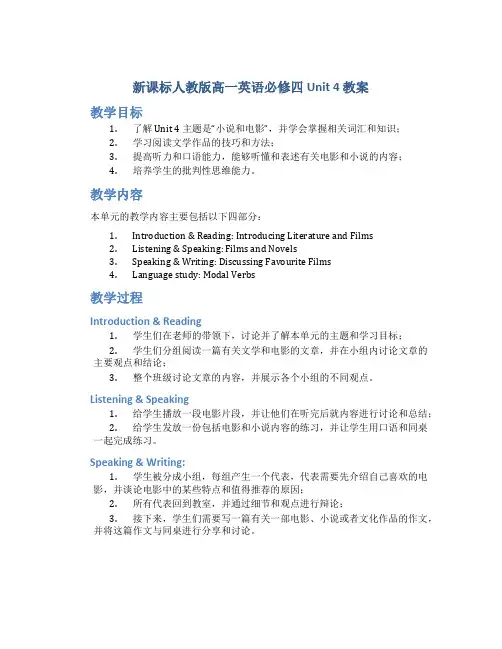
新课标人教版高一英语必修四 Unit 4 教案教学目标1.了解 Unit 4 主题是“小说和电影”,并学会掌握相关词汇和知识;2.学习阅读文学作品的技巧和方法;3.提高听力和口语能力,能够听懂和表述有关电影和小说的内容;4.培养学生的批判性思维能力。
教学内容本单元的教学内容主要包括以下四部分:1.Introduction & Reading: Introducing Literature and Films2.Listening & Speaking: Films and Novels3.Speaking & Writing: Discussing Favourite Filmsnguage study: Modal Verbs教学过程Introduction & Reading1.学生们在老师的带领下,讨论并了解本单元的主题和学习目标;2.学生们分组阅读一篇有关文学和电影的文章,并在小组内讨论文章的主要观点和结论;3.整个班级讨论文章的内容,并展示各个小组的不同观点。
Listening & Speaking1.给学生播放一段电影片段,并让他们在听完后就内容进行讨论和总结;2.给学生发放一份包括电影和小说内容的练习,并让学生用口语和同桌一起完成练习。
Speaking & Writing:1.学生被分成小组,每组产生一个代表,代表需要先介绍自己喜欢的电影,并谈论电影中的某些特点和值得推荐的原因;2.所有代表回到教室,并通过细节和观点进行辩论;3.接下来,学生们需要写一篇有关一部电影、小说或者文化作品的作文,并将这篇作文与同桌进行分享和讨论。
Language study本单元的语言学习环节将主要集中在Modal Verbs语法和习惯用法上。
学生需要通过阅读和翻译文本,以及完成会话练习和语言表达作业来掌握这一难点。
教学评估1.通过小组讨论和全班讨论来听取学生的观点和意见;2.通过听力和口语练习来检查学生的听力和口语能力;3.通过作文和语法作业来检测学生对知识点的掌握情况。
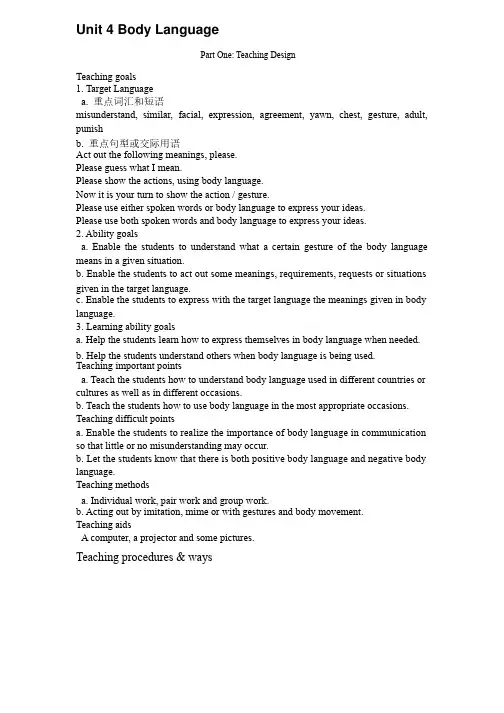
Unit 4 Body LanguagePart One: Teaching DesignTeaching goals1. Target Languagea. 重点词汇和短语重点词汇和短语misunderstand, similar, facial, expression, agreement, yawn, chest, gesture, adult, punishb. 重点句型或交际用语重点句型或交际用语Act out the following meanings, please.Please guess what I mean.Please show the actions, using body language.Now it is your turn to show the action / gesture.Please use either spoken words or body language to express your ideas.Please use both spoken words and body language to express your ideas.2. Ability goalsa. Enable the students to understand what a certain gesture of the body language means in a given situation.b. Enable the students to act out some meanings, requirements, requests or situations given in the target language.c. Enable the students to express with the target language the meanings given in body language.3. Learning ability goalsa. Help the students learn how to express themselves in body language when needed.b. Help the students understand others when body language is being used.Teaching important pointsa. Teach the students how to understand body language used in different countries or cultures as well as in different occasions.b. Teach the students how to use body language in the most appropriate occasions. Teaching difficult pointsa. Enable the students to realize the importance of body language in communication so that little or no misunderstanding may occur.b. Let the students know that there is both positive body language and negative body language.Teaching methodsa. Individual work, pair work and group work.b. Acting out by imitation, mime or with gestures and body movement.Teaching aidsA computer, a projector and some pictures.Teaching procedures & waysThe first period reading(COMMUNICATION: NO PROBLEM?)AimsTo help students develop their reading ability.To help students learn about body language.ProceduresI. Warming upWarming up by actingLook at the list of interpretation on the right side of the chart. Perform the action or the nonverbal behaviour on the left side.Examples Of Body LanguageWarming up by defining—What is body language?II. Pre-reading1. Looking and sayingLook at the man in the picture below. What does he say to you by his body language?Basically, how the ...... do I know? Or, I don’t know nothin! The shoulders are hunched and the hands are open signifying a big question mark.2. Talking and sharingBody language is the quiet, secret and most powerful language of all!According to experts, our non-verbal language communicates about 50% of what we really mean (voice tonality contributes 38%) while words themselves contribute a mere 7%.Our bodies send out messages constantly and often we don't recognize that we're communicating a lot more than we realize.Our understanding and use of non-verbal cues in facial expression are familiar to us nearly from birthIII. Reading1. Reading aloud to the recordingNow please listen and read aloud to the recording of the text COMMUNICATION: NO PROBLEM?. Pay attention to the pronunciation of each word and the pauses within each sentence. I will play the tape twice and you shall read aloud twice, too.2. Reading and underliningNext you are to read and underline all the useful expressions or collocations in the passage. Copy them to your notebook after class as homework.3. Reading to identify the topic sentence of each paragraphNext you are to skim the text to identify the topic sentence of each paragraph.4. Reading and transferring informationRead the text again to complete the table. Where is he/ she from? What does he/ she do when he/ she meet someone at the airport for the first time?Name Country Action MeaningMr GarciaJulia SmithAhmed AzizMadame Coulon5. Reading and understanding difficult sentencesAs you have read the text times, you can surely tell which sentences are difficult to understand. Now put your questions concerning the difficult points to me the teacher.6. Reading and translatingNow it’s time to translate the text into Chinese, sentence by sentence. Who will be the first to d o it?IV. Closing downClosing down by doing exercisesTo end the lesson you are to do the comprehending exercises No. 1 and 2 on page 26 and 27.Closing down by checkingC heck some of the following basic non-verbal cues and you'll recognize that you already speak and translate much of the language.“I’m surprised!” I’m shocked!” “I’m sad!”The second period Learning about Language(The ~ing form as the Attribute & Adverbial)I. Warming upWarming up by discovering useful words and expressionsTurn to page 27 and do exercises No. 1, 2 ,3 and 4 first. Check your answers against your classmates’.II. Learning about grammar1. Reading and thinkingTurn to page 25 and read with me the text of COMMUNICATION: NO PROBLEM? As you read along, pay attention to the uses of The ~ing form as the Attribute & Adverbial. (They are visitors coming from several countries. 作定语;Four people enter looking around in a curious way. 作状语;作状语; This is an exciting experience for you. 作定语; You stand watching and listening. 作状语;……)2. Doing exercises No. 1 and 2 on page 29Turn to page 29. Do exercises No. 1 and 2。
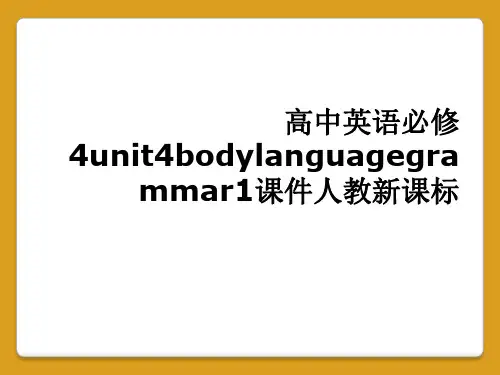
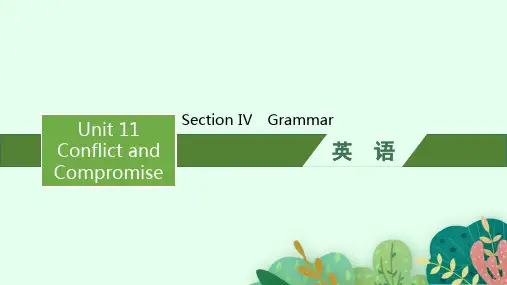
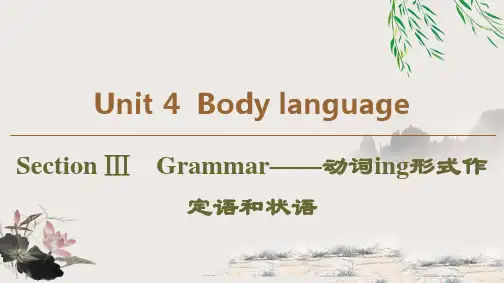
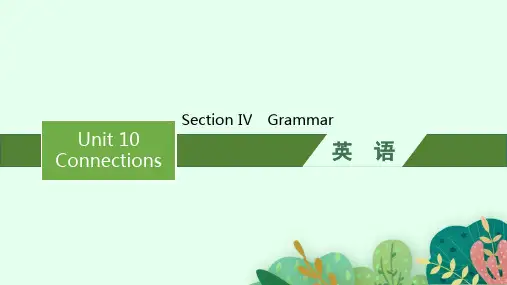
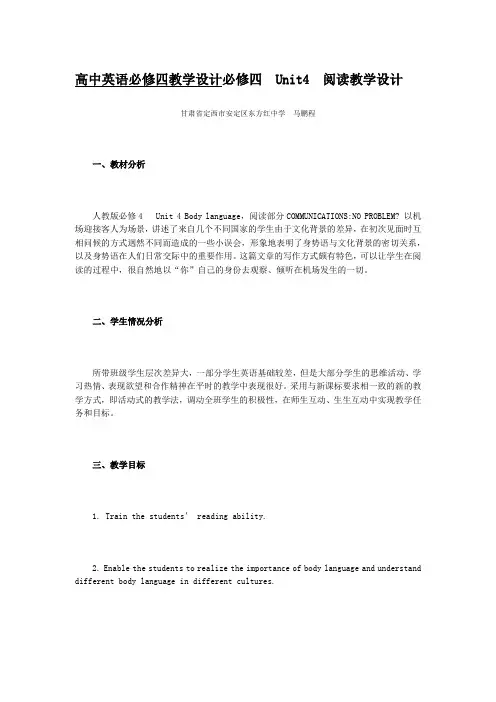
高中英语必修四教学设计必修四Unit4 阅读教学设计甘肃省定西市安定区东方红中学马鹏程一、教材分析人教版必修4 Unit 4 Body language,阅读部分COMMUNICATIONS:NO PROBLEM? 以机场迎接客人为场景,讲述了来自几个不同国家的学生由于文化背景的差异,在初次见面时互相问候的方式迥然不同而造成的一些小误会,形象地表明了身势语与文化背景的密切关系,以及身势语在人们日常交际中的重要作用。
这篇文章的写作方式颇有特色,可以让学生在阅读的过程中,很自然地以“你”自己的身份去观察、倾听在机场发生的一切。
二、学生情况分析所带班级学生层次差异大,一部分学生英语基础较差,但是大部分学生的思维活动、学习热情、表现欲望和合作精神在平时的教学中表现很好。
采用与新课标要求相一致的新的教学方式,即活动式的教学法,调动全班学生的积极性,在师生互动、生生互动中实现教学任务和目标。
三、教学目标1. Train the students’ reading ability.2. Enable the students to realize the importance of body language and understand different body language in different cultures.3. Stimulate the students’ interest and love for learning body language as well as to learn verbal language.四、教学方法1. Fast reading to get general idea of the text.2. Careful reading to understand the passage better.五、教学步骤Teaching ProceduresStep 1 Lead-inUse some pictures of Tai Lihua to lead in the topic.Step 2 Pre-reading1. Play a guess game: ask some students to act out the meanings in chart on page25, and have the rest students guess the meaning from the body language.2. Play another guess game: show some pictures of gestures and make the students speak out the meaning that each picture stands for.Step 3 Predict what the reading passage is aboutAsks the students to predict what the reading passage talks about according to the title and illustrations of the passage. The teacher can give some clues by talking about the illustrations:1. Where are the people?2. What are they doing?Step 4 Skimming1. Let the students skim the whole passage to get the main idea, then evaluate their predictions. During this activity, the teacher should give some guidance on reading skills. (The main idea is often related to the title. While skimming the text, pay attention to the first paragraph, the last paragraph and the first sentence of every paragraph.)Main idea of the passage:Some examples of cultural “body language” in greetingpeople.2. Let the students skim the passage and divide it into different parts to find out the main idea of every part and the topic sentences.Part 1 (paragraph1) Meet business people from several countries.Part 2 (paragraphs 2~4) Not all cultures greet each other the sameway.Part 3 (paragraph 5) A conclusion of the passage.Step 5 Careful readingHow do they behave when they greet people? Ask the students to scan the second part and complete the chart with information from the passage.Ask the students to read carefully and finish the following tasks.Exercise1: What were the two mistakes that the author noticed?He noticed that the Colombian man kissed the British woman, but in her culture, a kiss from a stranger is not acceptable. He also noticed that the Japanese man bowed just as the Canadian man started to shake hands, so one mans nose touched the other mans moving hand.Exercise 2: Read the statements and decide whether it is true or false and give the reasons.1. Englishmen often stand close to others or touch strangers as soon as they meet. (F)2. Most people around the world now greet each other by kissing. (F)3. Japanese will bow to others as greeting. (T)4. People from Jordan will move very close to you as you introduce yourself to them. (T)六、教学反思:本教学设计中学生的活动都具有明确的目的和具体的操作要求,实现了英语在真实情境中的应用。
高中英语必修4Unit4教案unit 4 body languagei.单元教学目标技能目标 skill goalstalk about body language: cultural differences and intercultural communicationpractise talking about prohibition & warning as well as obligationlearn to use the -ing form as the attribute&adverbiallearn to write a diary that showing the observation of how body language helps in communicationii.目标语言功能句式 talk about body languagewhat is the purpose of language?what do you think “body language” means?how can you tell if someone is sad or happy even if they do not speak?how can you communicate a feeling to someone who does not speak your language?why do we need to study body language?talk about cultural differences & intercultural communicationwhat do british people often do when they meet strangers?what do french people often do when they meet people they know?why should we be careful about our own body language? why is it important to watch others as well as listen to them?词汇 1.四会词汇 represent, association, canteen, dormitory, flight, curious, approach, major, misunderstand, dash, adult, crossroad2.认读词汇 unspoken,, jordan3.词组be likely to, in general, not all, turn one’s back to, lose face语法 4.重点词汇represent, introduce, approach, touch, express, nod, avoid, misunderstand, punish, general, curious, similar, expression, agreement, gesture, actionthe -ing form as the attribute && adverbialfinding out in the reading text sentences with present participle(s) used as the attribute or adverbial.1. the -ing form as the attributethey are visitors coming from several other countries, ...his nose touches mr. cook’s moving hand, ...this is an exciting experience for you, ...2. the -ing form as the adverbial... so you stand watching and listening.four people enter looking around in a curious way.you see her step back appearing surprised, and take a few steps away from mr. garcia.the visitor from japan comes in smiling at the same time as george cook from canada.ⅲ.教材分析和教材重组1.教材分析本单元以body language——“体态语”为中心话题,具体涉及什么是“体态语”,如何理解“体态语”,以及“体态语”的跨文化性等。
Background InformationAnalysis of the Teaching MaterialThis reading text is the key passage of Unit 3 which requires detailed reading. It mainly talks about a nonverbal master Charlie Chaplin’s personal experience, his major work and excellent personality.This passage talks about what makes Charlie Chaplin become a master of nonverbal humor. Besides, it can help to form a positive attitude towards hard situation.(价值取向)The writing genre of this passage is a narration. It develops the whole passage chronically (具体)and the main character’s major achievements.(structure)Analysis of the Students知识储备,阅读能力Teaching ObjectivesKey Points and Difficult PointsTeaching MethodsTeaching AidsTeaching ProcedureStep 1: Lead in1. Greeting with Ss.2. Show some famous nonverbals of Charlie Chaplin and invite Ss to guess who he is.Step 2: Pre-reading1. Read the title and the picture and encourage the Ss to guess what’s this passage about.2. Free talk “ how much do you know about Charlie Chaplin, and what words will you use to describe him?”Step 3: While reading1. Skim the passage and choose the best statement of what the passage is mainly about.2. Match each paragraph with the main idea.3. Scan 5 paragraphs and answer the following question.1) What kind of person do you think Charlie Chaplin is, why?2) What’s the image of the little tramp, can you perform some of his nonverbals?Step 4: Post-reading(output, interview拓展、海报)1. Work in pairs discuss these question about Charlie Chaplin.1) Do you think his poor childhood helped him in his work? Why?2) Why do you think he was so successful?3) What can we learn from him?Homework(写)办一个海报Find another master of humor that you like in China and write an article to introduce him and tell us why you like him, what he did and how did he sucess.Blackboard LayoutUnit 3 A Master of English HumorCharlie Chaplin Para1 high commentPerformer Para2 poor childhoodUnhappy childhood Para3 a successful image-the little tramp Talented Para4 tramp’s entertaining behavior Great confidence Para5 great achievemenThe little tramp 阅读通过形式去展现PoorHomelessMustacheLarge trousersWorn-out shoesSocial failureOptimismDeterminedTeaching reflectionAfter the class, I will reflect my class on the following aspects:。
外研版高中英语Book4 Module4单元教学设计一:单元设计的原那么:1:提前一周单元整体备课,每周一次集体备课,主备人和其他成员共同优化单元教学设计。
2:根据各部分之间的紧密关系来划分单元课堂讲解。
3:各堂课重点突出,突出不同课型的特点。
〔精读;泛读;语法;听力和写作课〕4:重难点突出,详略得当,敢于取舍。
〔不要低估学生的自主学习能力,把一些他们可以处理的部分交给学生处理,比如本模块中Everyday English;Pronunciation;Function.教师可以稍做引导或大胆放给学生〕。
二:各板块间的分析和重新组合:第一节课:单元词汇+Introduction +Speaking+Cultural Corner1: 目标:本节课重点是词汇,口语和泛读。
2:组合原因:单元词汇是基础〔原材料〕+Introduction 〔单元导入,激发学习兴趣〕+Speaking〔是针对Introduction 的第三部分的口语练习,是对Introduction 的巩固和提升〕+Cultural Corner〔以阅读带动单词的复习并有针对性的展开泛读能力的培养〕3:巩固练习:课本86页词汇练习5-8. 泛读练习:87页练习9是关于两位科学家:Yuan Rongping and Monty Jones 的泛读,很好的知识。
4:词汇处理方法:单词提前一周分工每天记忆下一单元的某些词汇,保证在下单元新课前掌握单词的读和写;单词的检查:每位同学课前在单独的单词检查本上写出自己认为比较重要的20个单词的汉语,课堂开始组内交换测试和修改,组长负责把握组内听写情况,教师可以及时了解和采取补救措施。
第二节课:Vocabulary and reading1: 目标:词汇和精读。
〔词汇的使用和阅读技巧的培养〕2:阅读问题的设计要有目的性,重点突出,多样性〔选标题,划分段落;找主旨句,单项选择,判断正误…〕,循序渐进〔选择最正确标题---写出最正确标题;找出主旨句------试着写出主旨句…〕;注重学习方法的启发。
Unit 4 Body LanguagePart One: Teaching Design (第一部分:教学设计)1.A sample lesson plan for reading(COMMUNICATION: NO PROBLEM?)AimsTo help students develop their reading ability.To help students learn about body language.ProceduresI. Warming upWarming up by actingLook at the list of interpretation on the right side of the chart. Perform the action or the nonverbal behaviour on the left side.Examples Of Body LanguageWarming up by defining—What is body language?II. Pre-reading1. Looking and sayingLook at the man in the picture below. What does he say to you by his body language? Basically, how the ...... do I know? Or, I don’t know nothin!The shoulders are hunched and the hands are open signifying a big question mark.2. Talking and sharingBody language is the quiet, secret and most powerful language of all!According to experts, our non-verbal language communicates about 50% of what we really mean (voice tonality contributes 38%) while words themselves contribute a mere 7%.Our bodies send out messages constantly and often we don't recognize that we're communicating a lot more than we realize.Our understanding and use of non-verbal cues in facial expression are familiar to us nearly from birthIII. Reading1. Reading aloud to the recordingNow please listen and read aloud to the recording of the text COMMUNICATION: NO PROBLEM?. Pay attention to the pronunciation of each word and the pauses within eachsentence. I will play the tape twice and you shall read aloud twice, too.2. Reading and underliningNext you are to read and underline all the useful expressions or collocations in the passage. Copy them to your notebook after class as homework.3. Reading to identify the topic sentence of each paragraphNext you are to skim the text to identify the topic sentence of each paragraph.4. Reading and transferring informationRead the text again to complete the table. Where is he/ she from? What does he/ she do when he/ she meet someone at the airport for the first time?5. Reading and understanding difficult sentencesAs you have read the text times, you can surely tell which sentences are difficult to understand. Now put your questions concerning the difficult points to me the teacher.6. Reading and translatingNow it’s time to translate the text into Chinese, sentence by sentence. Who will be the first to do it?IV. Closing downClosing down by doing exercisesTo end the lesson you are to do the comprehending exercises No. 1 and 2 on page 26 and 27.Closing down by checkingC heck some of the following basic non-verbal cues and you'll recognize that you already speak and translate much of the language.“I’m surprised!”“I’m shocked!”“I’m sad!”2.A sample lesson plan for Learning about Language (The ~ing form as the Attribute & Adverbial)AimsTo help students learn about The ~ing form as the Attribute & Adverbial.To help students discover and learn to use some useful words and expressions.To help students discover and learn to use some useful structures.ProceduresI. Warming upWarming up by discovering useful words and expressionsTurn to page 27 and do exercises No. 1, 2 ,3 and 4 first. Check your answers against your classmates’.II. Learning about grammar1. Reading and thinkingTurn to page 25 and read with me the text of COMMUNICATION: NO PROBLEM? As you read along, pay attention to the uses of The ~ing form as the Attribute & Adverbial. (They are visitors coming from several countries. 作定语;Four people enter looking around in a curious way. 作状语;This is an exciting experience for you. 作定语; You stand watching and listening. 作状语;……)2. Doing exercises No. 1 and 2 on page 29Turn to page 29. Do exercises No. 1 and 2。
人教版高中英语必修四 1 高效课堂教学设计:
(授课日期: 年 月 日 星期 班级 ) 授课题目 Unit4 Book4 Grammar 拟 课时 第 课时 明确目标 1、知识与技能: To help students learn about The ~ing form as the Attribute & Adverbial. To help students discover and learn to use some useful words and expressions. To help students discover and learn to use some useful structures. 2、过程与方法: Self-learning, cooperative-learning. 3、情感态度与价值观:To get Ss to have knowledge of the grammar point: The ~ing form as the Attribute & Adverbial. 重点难点 重点:Master The ~ing form as the Attribute & Adverbial 难点:How to use The ~ing form as the Attribute & Adverbial 课型 □讲授 □习题 □复习 □讨论 □其它 教 学 内 容 设 计 因材施教 Step I Warming up Warming up by discovering useful words and expressions Turn to page 27 and do exercises No. 1, 2 ,3 and 4 first. Check your answers against your classmates’. Step II Learning about grammar 1. Reading and thinking Turn to page 25 and read with me the text of COMMUNICATION: NO PROBLEM? As you read along, pay attention to the uses of The ~ing form as the Attribute & Adverbial. (They are visitors coming from several countries. 作定语;Four people enter looking around in a curious way. 作状语; This is an exciting experience for you. 作定语; You stand watching and listening. 作状语;……) 人教版高中英语必修四
2 2. Doing exercises No. 1 and 2 on page 29 Turn to page 29. Do exercises No. 1 and 2。 III. Ready used materials for The ~ing form as the Attribute & Adverbial ... When we use a verb in -ing form more like a verb or an adjective, it is usually a present participle:. Anthony is fishing. I have a boring teacher. In this lesson, we will look at the use of verbs in the ~ing form ... The ~ing form 作定语 现在分词可以单独作定语,也可以构成合成词作定语,但在更多的情况下是分词短语作定语,包括限定性和非限定性(用逗号与其他部分分开),在意义上相当于一个定语从句。现在分词作定语通常带有主动意义和未完成意义。例如: The man following was obviously in a hurry。(现在分词单独作定语) They acted just like a conquering army。(现在分词单独作定语) Do you know the man standing over there by the motor car?(分词短语作限定性定语。) Last night,we caught a thief stealing John's bike.(分词短语作限定性定语) The name Nebraske comes from the Oto Indian word “ebrathka”.meaning flat water.(分词短语作非限定性定语) The ~ing form 作状语 现在分词作状语表示主语在进行一动作的同时所进行的另一动作,它对谓语动词起修饰或陪衬的作用。这时要注意现在分词与其逻辑主语在时态和意义上的统一。例如: Rushing out of the room, he has knocked down by a car.(作时间状语) =When he rushed out of the room, he was hnocked down by a car. Working harder, you will pass the entrance exam.(作条件状语) =If you work harder, you will pass the entrance exam. 人教版高中英语必修四
3 She sat at a window and read a book.(作伴随状语) =She sat at a window and read a book. Having won the championship, he was awarded a million dollars.(作原因状语) =Because he had won the championship, he was awarded a million dollars. Even if taking a taxi, I will still be late for the meeting.(作让步状语) =Even if I take a taxi, I will still be late for the meeting. The road is under construction, thus causing the delay.(作结果状语) =The road is under construction, and thus caused the delay. 注意,当现在分词作让步状语时,一般放在句首,常常由although, though, even if ,unless等连词引入;作结果状语时,一般放在句末,前面可so, thus, henc。 IV. Closing down by doing a quiz To end the period you are going to take a quiz on ~ing words. ~ING WORDS Highlight all the words ending in '-ing'. Make lists of all the different categories of '-ing' words; that is, their different functions in the sentence. Examples of some of the different categories • He's swimming. • He's wearing a swimming suit. • He likes swimming. • Swimming is pleasant. Rewrite each sentence without using the '-ing' form. Is there a change in meaning? What is it? Find sentences in the text which can be rewritten using an -ing form. 人教版高中英语必修四 4 Is there any change in meaning? What is it? Step II: Leading in Find out the sentences which contain the modal verbs from the reading passage. 1. By lunchtime they would all be sold. 2. His restaurant ought to be full of people. 3. What could have happened? 4. Nothing could have been better? 5. Something terrible must have happened. 6. I will take all that fat off you in two weeks. 7. He could not believe his eyes. 8. He wondered if he should go to the library to find out. 9. He couldn’t have Yong Hui getting away with telling people lies. 10. He had better do some research. 11. After eating in the restaurant people would become fired very quickly. Step III Discovering useful structures Ask students to do the Exercise1&2 on Page11, then check the answers with their partners. Step III: Grammar point--- had better, should and ought to 1. When you give advice or your opinion about something, you can use had better or had better not. You had better get some rest. (=you’d better get some rest) You had better not eat fruit that isn’t ripe.(=you’d better not eat fruit that isn’t ripe) 2. When you are trying to advise someone about what to do or what not to do, you can use should / ought to or should not / ought not to. You should / ought to be careful with fruit. You should not / ought not to eat so much junk food. ( = you shouldn’t